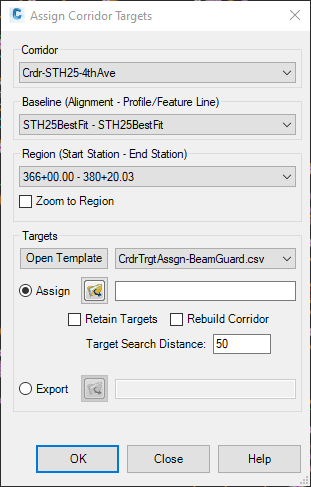Corridor - Assign Corridor Targets
Last updated: 2025-11-03
Overview
With standardized corridor target object names (edgeline alignment and control profiles for instance),the targeting of those objects to a subassembly and target parameter can be automated with this command.
- Preset input .csv files for WisDOT assemblies can be found at C:\WisDOT\Stnd\C3D20XX\Components\Assemblies with the naming convention CrdrTrgtAssgn-\*.csv
- To use this command with a custom assembly:
- Run this command first on the region to create a target mapping template .csv.
- Save this file in ..\<ProjectID>\Design\Corridors.
-
Enter target object naming wildcards in the first column of the .csv and save.
Tip: It is recommended to copy/paste naming conventions from C:\WisDOT\Stnd\C3D2020\Components\Assemblies and use those naming standards for objects.
- Run the command with the custom .csv to set corridor targets.
Usage
WisDOT Design tab > Design panel > Corridor menu > Assign Corridor Targets
The tool can also be accessed from the command line: DOTASSIGNCORRIDORTARGETS, or from the Corridor right click menu.

- Select the Corridor. If Assign Corridor Targets was accessed from the corridor right click menu, the selected corridor will already be active in the menu.
- Select the Region(s) from the tree view. Assign Corridor Targets can process multiple regions when assigning targets. When using the export option, only one region may be selected.
- Right-click on any region or baseline and select Zoom to, to zoom to the region or baseline in modelspace.
Use the Select regions from drawing button to graphically select the region(s) from the drawing.
Targeting can be done in two ways:
- If you are using an assembly available off of the WisDOT Subassemblies tool palette, you can select the corresponding template and assign targets.
- If you want to use the tool with a custom assembly,
- You can either modify a template until it matches your assembly or you can export the definition of an assembly that is in a corridor and add the targeting information to it.
Then use the custom template you created to assign targets.
- Targets: Export option
- To create a target mapping ..csvfile based on the selected region, select the Export radio button.
- Click the folder icon to set the .csvname and save location.
- Click OK
-
Edit and save the .csv file
Enter a portion of the object name(s) with wildcards to uniquely identify an object as a target. If target is a feature line add TRUE to fields of Is Feature Line? column.
Info:- This function does support use of * wildcards in the object names.
- Subassembly needs to be the specific name within the assembly, not the generic subassembly name.
- Often subassemblies and their targets are specific to side (Left/Right). Subassemblies and target objects should be named to their appropriate side relative to the baseline.
- If more than one object naming convention should be assigned to a target parameter, copy the row for each object and edit the object name field.
- By default, the targets will be assigned so the nearest/flattest object is targeted. Type Farthest or Steepest in the target option column to target the farthest instead.
- If you would like to override the default target search distance for a particular target, set the distance in the offset target search distance column.
Examples object name offset target search distance subassembly target parameter target parameter type target option (default = "Nearest") is feature line? Exist* DaylightProfileControlled-GradingLine-L Daylight surface Surface -L-EGS* UnpavedShld-L Unpaved width Offset Farthest -R-ShldrFslp UnpavedShld-R Foreslope from profile Elevation
- Targets: Export option
- To create a target mapping ..csvfile based on the selected region, select the Export radio button.
- Click the folder icon to set the .csvname and save location.
- Click OK
-
Edit and save the .csv file
Enter a portion of the object name(s) with wildcards to uniquely identify an object as a target. If target is a feature line add TRUE to fields of Is Feature Line? column.
Info:- This function does support use of * wildcards in the object names.
- Subassembly needs to be the specific name within the assembly, not the generic subassembly name.
- Often subassemblies and their targets are specific to side (Left/Right). Subassemblies and target objects should be named to their appropriate side relative to the baseline.
- If more than one object naming convention should be assigned to a target parameter, copy the row for each object and edit the object name field.
- By default, the targets will be assigned so the nearest/flattest object is targeted. Type Farthest or Steepest in the target option column to target the farthest instead.
- If you would like to override the default target search distance for a particular target, set the distance in the offset target search distance column.
Examples object name offset target search distance subassembly target parameter target parameter type target option (default = "Nearest") is feature line? Exist* DaylightProfileControlled-GradingLine-L Daylight surface Surface -L-EGS* UnpavedShld-L Unpaved width Offset Farthest -R-ShldrFslp UnpavedShld-R Foreslope from profile Elevation
-
OK